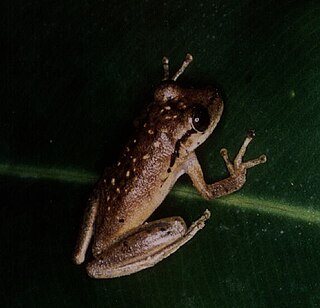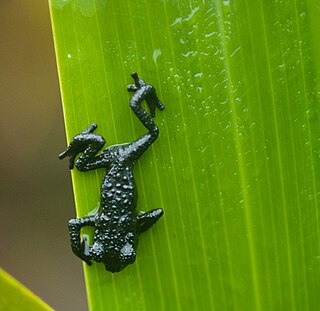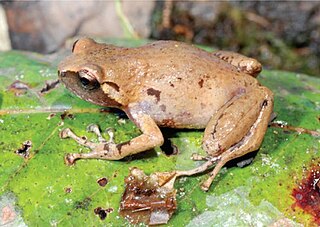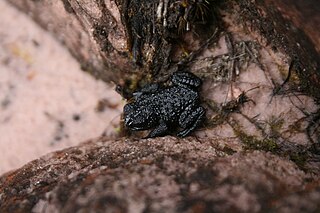
Osteopilus is a genus of frogs in the family Hylidae. These species have a bony co-ossification on the skull resulting in a casque, hence its name ‘bone-cap’, from osteo- (‘bone’) and the Greek pilos. Color varies between uniform brown, brown-gray, or olive with darker markings or marbled with greens, grays or brown, making a distinct pattern. The finger disks are round; the fingers with a reduced webbing; eyes and tympanum are large. Their natural range includes the Greater Antilles and the Bahamas, but O. septentrionalis has also been introduced to the Lesser Antilles, Hawaii and Florida (USA).

Scinax is a genus of frogs in the family Hylidae found in eastern and southern Mexico to Argentina and Uruguay, Trinidad and Tobago, and Saint Lucia. These are small to moderate-sized tree frogs, drably colored. Duellman and Wiens resurrected this genus in 1992. The name originates from the Greek word skinos, meaning quick or nimble.

Trachycephalus is a genus of frogs, commonly known as the casque-headed tree frogs, in the family Hylidae. They are found in Mexico, Central America, and South America. In a recent revision, the seven species of the genus Phrynohyas were included in this genus, and Phrynohyas is now considered a synonym of Trachycephalus. These frogs inhabit the canopies of tropical rainforests, where they breed in tree cavities, and seldom, if ever, descend to the ground.

Triprion is a genus of frogs in the family Hylidae found in the Pacific lowlands of Mexico, the Yucatán Peninsula, and Guatemala. These frogs hide in tree-holes and plug the entrance with their strange-looking, bony heads.

Pseudacris is a genus of frogs in the family Hylidae found in North America ranging from the Pacific coastline to the Atlantic.

Phyllodytes is a genus of frogs in the family Hylidae. It is endemic to eastern Brazil.

Osteocephalus is a genus of frogs, the slender-legged tree frogs, in the family Hylidae found in the Guianas, the Amazon Basin, Venezuela, Colombia, southeastern Brazil, and north-eastern Argentina. Males are warty, while females are smooth.

Nyctimantis is a genus of frogs in the family Hylidae. The genus is found in south-eastern Brazil as well as in the Orinoco Basin in Venezuela, Colombia, and Brazil. These are tree-dwelling species usually hiding in the cisterns of epiphytic bromeliads. The top of the head carries a bony plate which is fused with the skin.

Ansonia is a genus of true toads found in south India, northern Thailand, Malay Peninsula, Tioman Island, Borneo, and Mindanao (Philippines). These small forest species spawn in streams and have torrent-adapted tadpoles. Common name stream toads has been coined for the genus, although individual species are also being referred to as slender toads.

Capensibufo is a genus of true toads commonly known as Cape toads or mountain toadlets. They are found in the Republic of South Africa from Breede River to north of Knysna, Western Cape Province.

Nectophryne, or African tree toads, is a small genus of true toads with only two species. They are native to West and Central Africa: Nigeria, Cameroon, Gabon, northeastern Congo, Bioko and Equatorial Guinea. Nectophryne afra uses small bodies of water to lay its eggs which are then guarded by the male.

Oreophrynella, commonly known as bush toads, is a genus of true toads native to the tepuis of southern Venezuela and adjacent Guyana. The distribution of some species is restricted to a couple of tepuis or even a single tepui, as in the case of Oreophrynella weiassipuensis, which occurs on Wei-Assipu-tepui.

Osornophryne is a genus of true toads endemic to the Cordillera Central in Colombia and central Andes in Ecuador.

Cophixalus is a genus of microhylid frogs. These are arboreal species with expanded toe-pads, endemic to Moluccan Islands, New Guinea and northeastern Queensland, Australia.

Oreophryne, the cross frogs, is a genus of microhylid frogs endemic to Southern Philippine, Celebes and the Lesser Sunda Islands, and New Guinea.

Oreophrynella nigra, or pebble toad, is a species of toad in the family Bufonidae. It is endemic to the Guiana Highlands in Bolívar State, Venezuela, and known from two tepuis, Kukenan-tepui and Yuruani-tepui, both belonging to the Eastern Tepuis.
The Monte Duida tree frog is a species of frog in the family Hylidae. It is endemic to Venezuela and only known from the Cerro Duida, its type locality in the Amazonas state of southern Venezuela. Its natural habitat is montane tepui vegetation, specifically forest and shrubs adjacent to rivers, streams, and peat bogs. No significant threats to this species occurring in the Duida-Marahuaca National Park are known.
Tepuihyla luteolabris is a species of frog in the family Hylidae endemic to Venezuela where it can be found on a number of tepui. Its natural habitat is high montane tepui vegetation. Reproduction takes place in rivers.

Josefa Celsa Señaris is a Venezuelan herpetologist. She has published information about frogs and she has identified new genera and species. Señaris is the director of the La Salle Foundation's Natural History Museum in Caracas.
Cerro Jaua is a tepui in Bolivar State, Venezuela. The mountain has a height of 2395 meters, It was included in Jaua-Sarisariñama National Park which has been subsumed within Caura National Park.

















